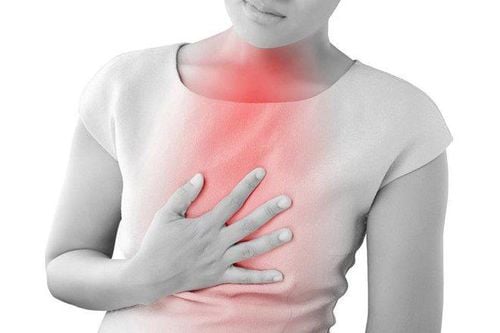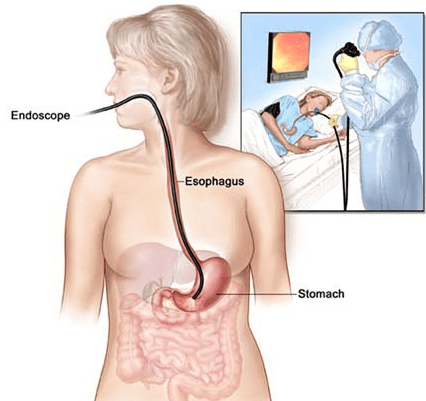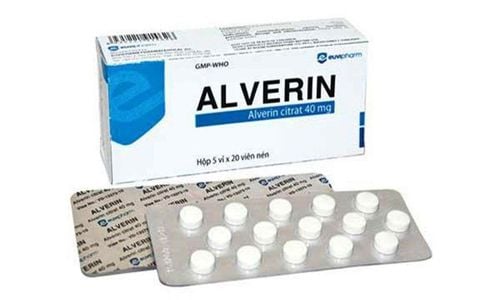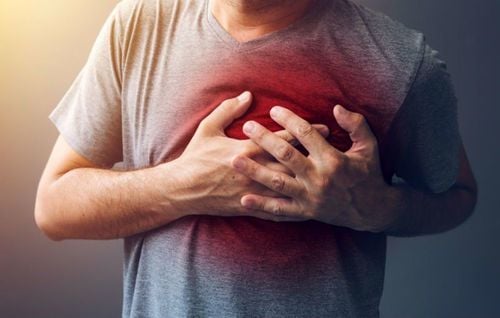This is an automatically translated article.
Posted by Master, Doctor Mai Vien Phuong - Department of Examination & Internal Medicine - Vinmec Central Park International General HospitalThe main underlying mechanisms of noncardiac chest pain include gastroesophageal reflux, esophageal dysfunction, and esophageal hypersensitivity. Gastroesophageal reflux disease may be the most common cause of noncardiac chest pain.
1. Mechanism of gastroesophageal reflux disease causing noncardiac chest pain
The mechanism by which GERD causes noncardiac chest pain is not well understood. It is not clear why esophageal contact with gastric juice in some patients causes heartburn and in others chest pain.Characterization of individual reflux episodes (duration and pH level) have been suggested to influence patient symptoms. Smith et al studied 25 people with noncardiac chest pain to determine the link between pain sensation in GERD and the pH of refluxed fluid. They found that all 25 patients experienced pain relief when a solution of pH 1 and 1.5 was infused into the esophagus. Reflux events that result in pain last significantly longer than those without pain and are often related to a previous recent episode of pain.

2. Role of esophageal hypersensitivity in patients with noncardiac chest pain
Different underlying mechanisms have been suggested to lead to esophageal hypersensitivity in patients with noncardiac chest pain. These include peripheral sensitization of esophageal sensory directions leading to a higher response to physiological and pathological stimuli and modulation of afferent nerve function at the dorsal spinal root or nervous system level. center .In 1 study, healthy subjects received distal esophageal perfusion with normal saline or 0.1 N hydrochloric acid. Perceptual responses to intraoral balloon distension were assessed by using an electronic barostat. Compared with saline, acid infusion lowers the sensory threshold (innocuous sensations) and tends to decrease the pain threshold (repulsive sensations). This study demonstrated short-term sensitization of mechanistically induced afferent pathways by transient acid exposure.
The authors suggest that in patients with noncardiac chest pain, acid reflux causes sensitization of the esophagus, which may then alter the way the esophagus perceives other than normal dilation of the esophagus. esophagus.
3. Patients with noncardiac chest pain present with visceral hypersensitivity and secondary esophageal allergy
Sarkar et al recruited 19 healthy volunteers and 7 patients with noncardiac chest pain. Hydrochloric acid is infused into a balloon placed in the distal esophagus for 30 minutes. Sensory responses to electrical stimulation were monitored in acid-exposed radiation esophagus and non-exposed proximal esophagus before and after infusion.In healthy individuals, acid infusion into the distal esophagus reduces the pain threshold in the upper esophagus. Patients with noncardiac chest pain had a lower threshold for esophageal pain at rest than healthy subjects. After acid infusion, their pain threshold in the proximal esophagus decreased further and for a longer time than was the case in healthy subjects.
In addition, there was a decrease in pain threshold after acid infusion into the anterior chest wall. This study demonstrated the development of secondary atopy (visceral hypersensitivity to harmless stimuli in normal tissue near the site of tissue damage) in the proximal esophagus due to repeated acid exposure. of the distal esophagus.
Concurrent visceral hypersensitivity and neuropathic pain are most likely caused by central sensitization (an increase in excitability of spinal nerve cells due to activation of sensory C fibers in the spinal cord). tissue damage).

4. The duration of esophageal spasm determines the type of symptoms the patient notices
Another explanation for how GERD can cause chest pain has been provided by studies using high-frequency intraluminal ultrasound. Balaban et al demonstrated a temporal correlation between continuous contractions of the longitudinal esophageal muscle and spontaneous as well as irritable esophageal angina. In a follow-up study, the authors suggested that prolonged esophageal contractions determine the type of symptoms that patients notice. Heartburn is associated with contractions of shorter duration, while chest pain is associated with contractions of longer duration. In a recent study, the authors suggested that esophageal muscle thickness, in the absence of esophageal motility abnormalities, could lead to symptoms of chest pain.Studies have demonstrated that patients with noncardiac chest pain with evidence of GERD (endoscopic detection and/or abnormal esophageal pH measurement) generally respond to treatment with antireflux therapies.
Between 78%-92% of patients with noncardiac chest pain with objective evidence of GERD show improvement in symptoms with antireflux therapy. In contrast, response to PPI antagonist therapy in patients with noncardiac chest pain without objective evidence of GERD ranged from 10% to 14%.
It Kushnir et al demonstrated that an elevated probability of a combination of positive symptoms and duration of acid exposure predicts response to PPI treatment in patients with noncardiac chest pain. When used hierarchically, response to antireflux therapy was predicted when GERD parameters (time to acid exposure, probability of symptom association, and symptom index) were both abnormal and poorest. when all is normal. These data suggest a causal relationship between the patient's GERD and chest pain symptoms.

Experienced doctors in endoscopy. Modern equipment, high treatment efficiency: C-Am system, intraoperative ultrasound machine helps to locate the position and help the surgeon to monitor the patient's condition during and after surgery. to be able to bring good endoscopic results, limit complications during and after surgery. Germany's most modern flexible endoscope system for clear, accurate images, easy to use. Intraoperative consumables are passed through strict sterilization testing procedures, Vinmec only uses high quality products and especially is used only once to ensure sterility and deliver results. good for the patient. With modern facilities, accurate diagnosis, selection of appropriate surgical methods, customers only take a single dose of prophylactic antibiotics, do not have to use high-dose antibiotics for a long time, no pain, no hospital stay. short, only 1-2 days. Therefore, saving treatment costs Professional services: Modern civilized disease prevention system, each patient one room is fully serviced from monitoring disease parameters, meals, rest regimes Rest, exercise, health education, each room is equipped with amenities like a hotel apartment, patient information is confidential.
Please dial HOTLINE for more information or register for an appointment HERE. Download MyVinmec app to make appointments faster and to manage your bookings easily.
References: Ronnie Fass and Sami R Achem, Noncardiac Chest Pain: Epidemiology, Natural Course and Pathogenesis, J Neurogastroenterol Motil. 2011 Apr; 17(2): 110–123.













